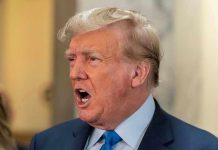
President Trump federalizes 2,000 National Guard troops in Los Angeles after ICE agents come under attack from violent protesters, overriding California Governor Gavin Newsom’s objections in a show of federal authority not seen since 1965.
Key Takeaways
- President Trump bypassed state authority to deploy 2,000 National Guard troops to Los Angeles following violent anti-immigration protests, marking the first such federal action since 1965.
- Governor Gavin Newsom condemned the deployment as “a serious breach of state sovereignty” and threatened legal action, claiming local law enforcement resources were sufficient.
- The protests erupted after ICE conducted major workplace raids, arresting 44 unauthorized immigrants at a job site and 77 others across the greater LA area.
- Violence escalated with vehicles being set on fire, federal buildings targeted, and dozens arrested, prompting Trump to condemn “violent, insurrectionist mobs.”
- The Guard’s mission is specifically to protect federal agents conducting immigration enforcement, not to participate in raids or routine policing.
Trump Takes Unprecedented Action After Immigration Protests Turn Violent
In a decisive use of presidential authority, Donald Trump has federalized 2,000 California National Guard troops to protect immigration enforcement officials in Los Angeles. The action comes after protesters clashed with Immigration and Customs Enforcement (ICE) agents conducting raids in Latino-populated areas of the city. This marks the first time since the 1965 Watts riots that a president has directly activated state troops without the governor’s consent, demonstrating Trump’s commitment to his aggressive immigration enforcement agenda that has targeted Los Angeles as a primary focus.
The protests began after ICE operations in the Westlake and Paramount neighborhoods resulted in the arrest of 44 unauthorized immigrants at a job site and 77 others throughout the greater Los Angeles area. What started as demonstrations quickly escalated, with vehicles set ablaze, looting reported, and downtown LA declared an “unlawful assembly” area. Police responded with flash-bang grenades and pepper spray as protesters targeted the Federal Building in downtown LA and a Home Depot in Paramount, where raids had occurred.
Street Siege in LA: Immigration Protests Erupt into Riot as Rioters Trap CHP Below 101 Freeway
By @drkugler | https://t.co/FA5Tcn6fs7 | June 9, 2025
Downtown Los Angeles turned into a war zone this weekend as immigration protests spiraled into full-blown urban… pic.twitter.com/aVhTFjxfsU
— SubX.News® (@SubxNews) June 9, 2025
State-Federal Power Struggle Erupts Over Guard Deployment
Governor Gavin Newsom’s opposition to the troop deployment has created a stark power struggle between California and the federal government. Newsom formally requested that Trump return control of the Guard to the state, arguing that local law enforcement resources are adequate to handle the situation. “We didn’t have a problem until Trump got involved. This is a serious breach of state sovereignty, inflaming tensions while pulling resources from where they’re needed,” said Gov Gavin Newsom.
Legal experts suggest Trump’s action falls under a different authority than the Insurrection Act, but could still face court challenges. While presidents do have the power to federalize the National Guard under certain circumstances, critics contend this particular use pushes constitutional boundaries. The Defense Secretary has even mentioned the potential mobilization of Marines if violence continues, further escalating federal involvement in what California officials view as a state and local matter.
Clash Over Immigration Enforcement Strategy
Trump has characterized the protesters as “violent, insurrectionist mobs” representing “a form of rebellion against the authority of the government of the United States,” said US President Donald Trump.
The National Guard’s mission is specifically limited to protecting federal agents conducting immigration enforcement operations, not participating in raids themselves or handling routine policing duties. ICE reported that “over 1,000 rioters” threatened their agents, necessitating the additional security. The deployment aligns with Trump’s broader immigration strategy, which aims to conduct the largest deportation campaign in U.S. history. ICE’s daily arrest goals have reportedly increased to 3,000, with workplace enforcement becoming a key focus.
Constitutional Concerns Raised By Both Sides
Civil liberties advocates have raised serious concerns about both the deployment and some of Trump’s statements regarding protesters. “President Trump’s deployment of federalized National Guard troops in response to protests is unnecessary, inflammatory, and an abuse of power,” said Hina Shamsi, Director of the ACLU’s National Security Project.
Trump’s comments about masked protesters have particularly drawn criticism on First Amendment grounds. “The ability to protest anonymously is quite settled, the use of masks specifically,” noted Thomas R. Burke, a First Amendment attorney. Meanwhile, conservatives have defended the president’s actions as necessary to uphold federal immigration law that California officials have systematically undermined through sanctuary policies. The deployment reflects Trump’s commitment to asserting federal supremacy on immigration matters and protecting ICE agents trying to fulfill their lawful duties despite local resistance.







